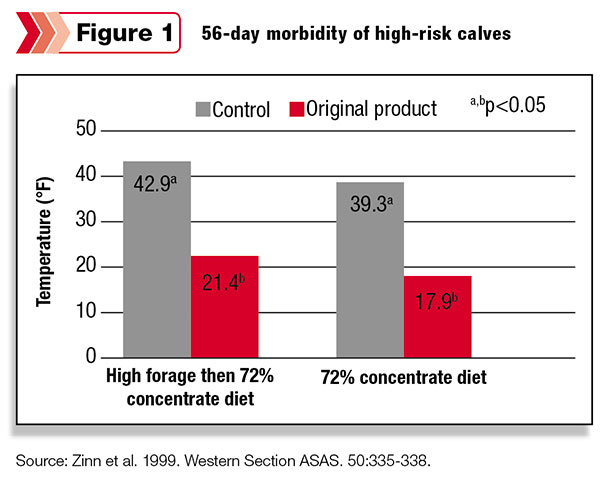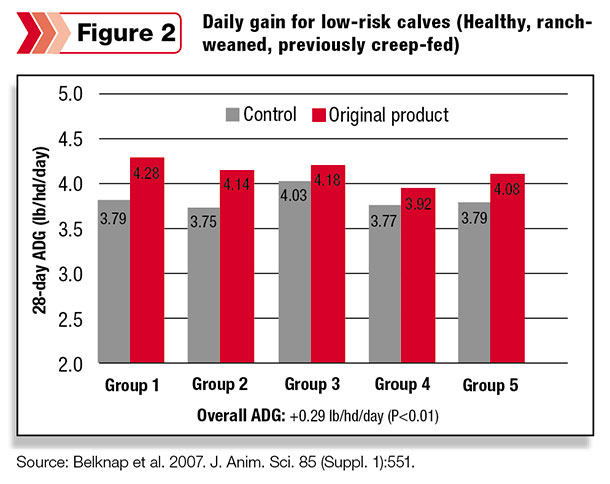This plan may include prescription use of antibiotics along with the use of natural non-antibiotic alternatives that can potentially affect calf health and performance.
You want to be ready because weaning and receiving into the feedlot stresses cattle, making them more vulnerable to opportunistic pathogens and disease. Research shows that cattle that get sick just once in their lives are less profitable throughout the entire feeding period.
If you’re concerned about weaning and receiving health, and you’re considering non-antibiotic alternatives, what are your options?
Probiotics, prebiotics and more
The gastrointestinal tract contains about 70 percent of all the calf’s immune cells. While these cells are the calf’s first line of immune defense, they also represent a potential weak point for the invasion of pathogens. Even though these pathogens may not cause infection themselves, they can act to weaken immune defenses.
Non-antibiotic feed additive products include probiotics, prebiotics and microbial fermentation metabolites. Research in this field shows such products often have beneficial effects in supporting gastrointestinal health and growth during the weaning and receiving stages.
Probiotics or “direct-fed microbials” are micro-organisms (most often bacteria or fungi) that must be fed in a live, viable state in order to maintain effectiveness. These organisms are intended to either propagate or create a more favorable environment in the digestive tract of the animal, thereby promoting digestive function.
However, because these are live organisms, most probiotic products require special packaging and cold storage in order to survive and remain effective. One should be cautious of any such “live” probiotic product that is not packaged in an airtight, moisture-tight package.
Oxygen, heat and moisture in the air all have a negative effect on the viability of these organisms. In addition, feed storage conditions and feed processing can also have a detrimental effect on the viability of these organisms.
Unlike probiotics, prebiotics are not living organisms but may consist of botanical or plant-source ingredients, essential oils or mannan oligosaccharides (MOS). Theoretically, prebiotics are not digested by the calf but function instead to promote growth of beneficial gut bacteria or to attract pathogenic bacteria in order to excrete them.
Some studies with probiotics and prebiotics have shown beneficial effects on health or production, but others have shown no benefits to including either type of product. Research into these products has continued, now spurred on by the impending VFD.
What we do know is that the growth of beneficial bacteria in the gastrointestinal tract can help maintain good overall gut health and nutrient digestibility. Is there another all-natural way to optimize these effects?
Fermentation metabolites
Precisely controlled fermentation of Saccharomyces cerevisiae has produced a product containing unique bioactive metabolite compounds. The product’s beneficial bioactive fermentation metabolites include proteins, peptides, antioxidants, phytosterols, organic acids and nucleotides. The product also contains residual cell components, including MOS and beta-glucans.
Research with “high-risk” calves has shown that this product reduced 56-day morbidity of high-risk starter cattle by more than half (Figure 1). 
Moreover, producers and researchers alike have found that this product has also been shown to help get cattle eating while improving their rumen function. Proper rumen function helps support optimum use of dietary energy, protein and other nutrients, which produces healthier, faster-growing cattle.
While not all newly weaned or received cattle are going to experience a high degree of sickness, there is no denying that various rumen stressors, common on any feedyard or backgrounding yard, can still have a detrimental effect on animal performance.
Animal processing, commingling, ration changes, inconsistent feeding times, weather factors, mycotoxins and a multitude of other factors can and will depress rumen performance, even in low-risk cattle. Research has also shown that an effective starter program using this fermentation product can help optimize rumen performance in low-risk cattle (Figure 2). 
Better rumen performance expressed itself in more consistent feed intake, increased weight gain and improved feed conversion.
Finally, research has even shown the benefits of feeding the product throughout the entire grow/finish period. An independently conducted meta-analysis at Colorado State University of 28 trials and more than 7,600 cattle fed the fermentation metabolites product showed improved weight gain and feed conversion from start to finish.
Optimizing the growth of beneficial bacteria in the gastrointestinal tract by all-natural means, including precisely controlled fermentation metabolites, can have a beneficial effect on calf health and performance.
While products like these may be used in situations where producers are looking to avoid the use of antibiotics, they may also be used in conjunction with a conventional program which also takes advantage of veterinarian-prescribed antibiotics. ![]()
References omitted due to space but are available upon request. Click here to email an editor.

-
Craig Belknap
- Beef Field Technical Specialist
- Diamond V
- Email Craig Belknap







